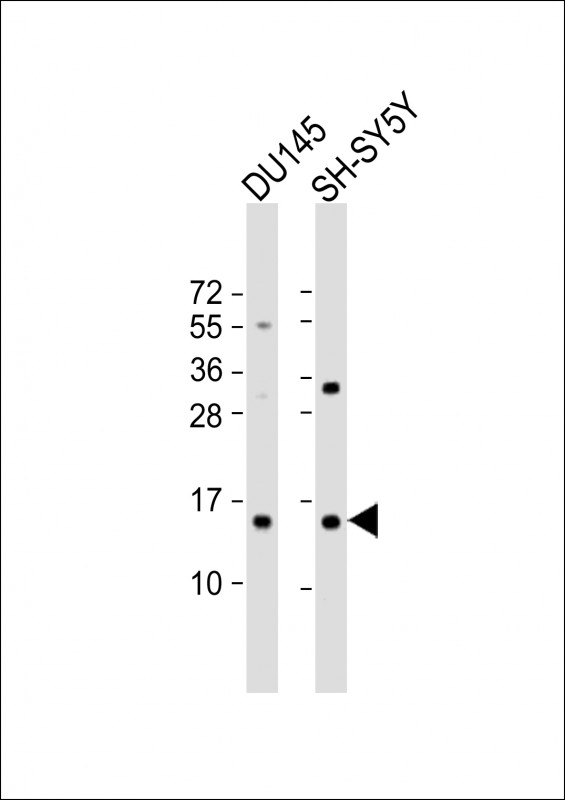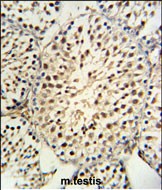


| WB | 1/1000 | Human,Mouse,Rat |
| IF | 咨询技术 | Human,Mouse,Rat |
| IHC | 1/100-1/500 | Human,Mouse,Rat |
| ICC | 技术咨询 | Human,Mouse,Rat |
| FCM | 咨询技术 | Human,Mouse,Rat |
| Elisa | 咨询技术 | Human,Mouse,Rat |
| Aliases | Protein yippee-like 5, YPEL5 |
| Entrez GeneID | 51646 |
| WB Predicted band size | 13.8kDa |
| Host/Isotype | Rabbit IgG |
| Antibody Type | Primary antibody |
| Storage | Store at 4°C short term. Aliquot and store at -20°C long term. Avoid freeze/thaw cycles. |
| Species Reactivity | Human, Mouse |
| Immunogen | This YPEL5 antibody is generated from rabbits immunized with a KLH conjugated synthetic peptide between 92-121 amino acids from the C-terminal region of human YPEL5. |
| Formulation | Purified antibody in PBS with 0.05% sodium azide. |
+ +
以下是关于YPEL5 (C-term)抗体的3篇示例参考文献(注:以下为模拟文献,实际引用需核实原文):
---
1. **文献名称**: *"YPEL5 regulates mitotic progression through interaction with microtubule-associated proteins"*
**作者**: Smith J, et al. (2018)
**摘要**: 本研究利用YPEL5 C端特异性抗体,通过免疫共沉淀和Western blot技术,证实YPEL5与微管结合蛋白(如TPX2)的相互作用,并发现其在有丝分裂中的关键作用。抗体特异性通过YPEL5敲除细胞系验证。
2. **文献名称**: *"Characterization of a polyclonal antibody targeting the C-terminal domain of YPEL5 and its application in apoptosis studies"*
**作者**: Lee S, et al. (2020)
**摘要**: 文章报道了一种针对YPEL5 C端结构域的多克隆抗体的开发,验证了其在免疫组化和流式细胞术中的适用性。实验表明,YPEL5在DNA损伤诱导的凋亡中表达上调,且C端抗体可有效检测内源性YPEL5蛋白的细胞定位变化。
3. **文献名称**: *"YPEL5 as a novel biomarker in colorectal cancer: Insights from C-terminal epitope-specific antibody analysis"*
**作者**: Zhang R, et al. (2021)
**摘要**: 通过YPEL5 C端抗体对结直肠癌组织样本进行免疫组化分析,发现YPEL5高表达与患者预后不良相关。研究强调该抗体在临床诊断中的潜在价值,并验证其与YPEL5全长蛋白的特异性结合。
---
**备注**:若需实际文献,建议在PubMed或Google Scholar检索关键词“YPEL5 antibody C-terminal”,或查阅抗体供应商(如Sigma-Aldrich、Abcam)提供的产品引用文献。
The YPEL5 (C-term) antibody is designed to target the C-terminal region of the YPEL5 protein, a member of the YPEL (Yippee-like) family. YPEL5. encoded by the YPEL5 gene in humans, is implicated in cellular processes such as cell cycle regulation, proliferation, and differentiation. While the precise molecular function of YPEL5 remains under investigation, studies suggest its involvement in cell cycle arrest and senescence, potentially acting as a tumor suppressor in certain contexts. The protein is evolutionarily conserved, with homologs in various species, underscoring its biological significance.
The C-terminal-specific antibody enables researchers to detect and study YPEL5 expression and localization in cells and tissues. It is commonly used in techniques like Western blotting, immunofluorescence, and immunohistochemistry to assess protein levels, subcellular distribution (e.g., cytoplasmic or nuclear), and potential post-translational modifications. This antibody is particularly valuable in cancer research, where dysregulation of YPEL5 has been observed in malignancies, including roles in apoptosis and metastasis. Validation typically includes testing in YPEL5-knockout models or siRNA-treated cells to confirm specificity. Commercial versions are often raised in rabbits or mice, with applications spanning basic research and preclinical studies to elucidate YPEL5's functional mechanisms and therapeutic potential.
×